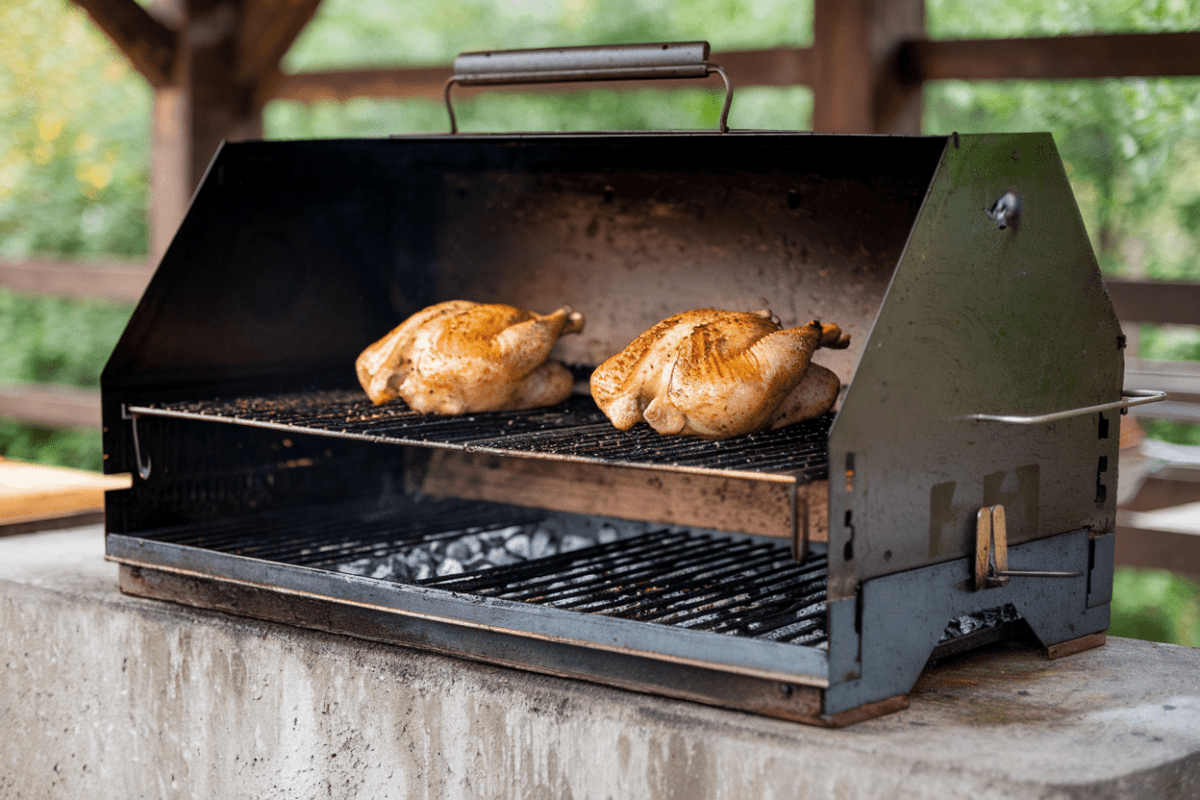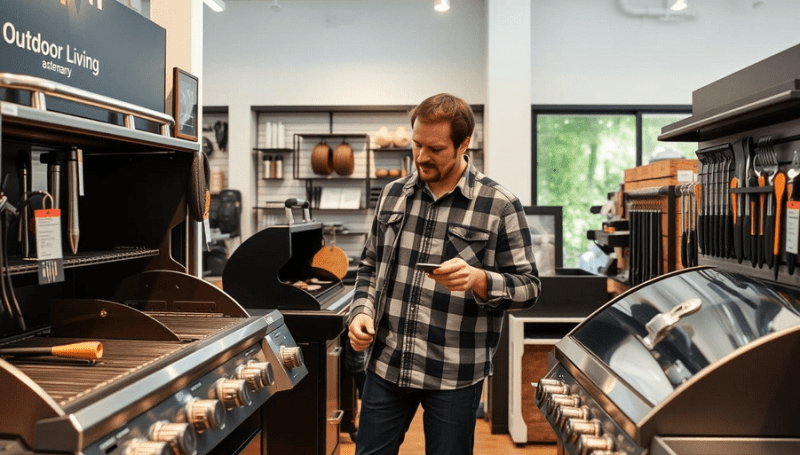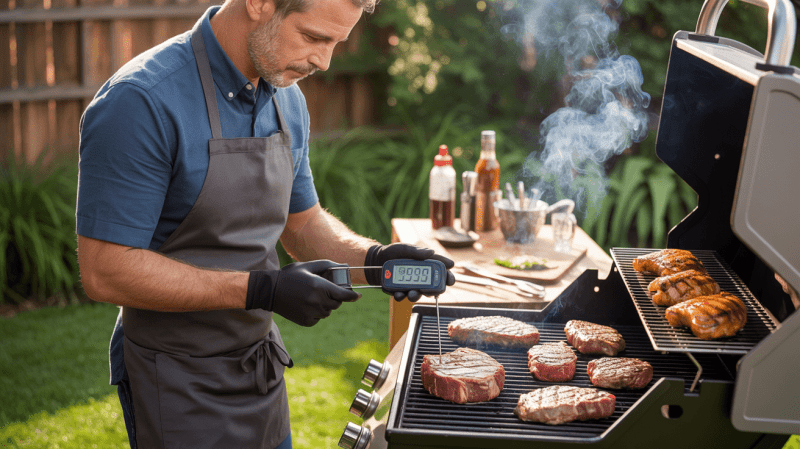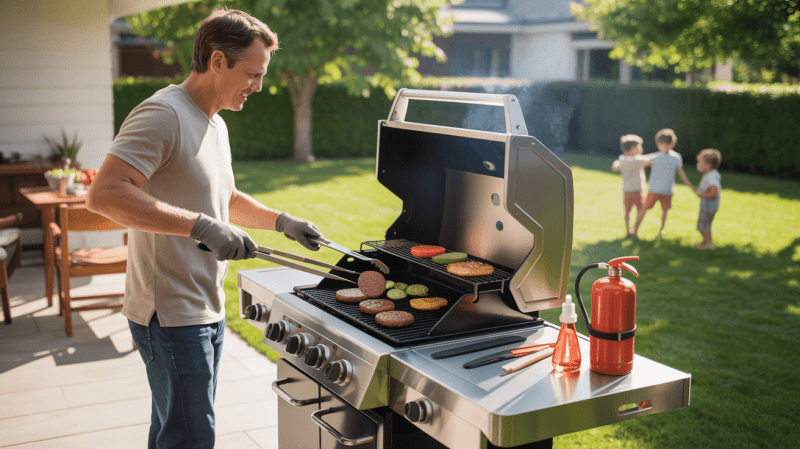Chicken Grilling Tips:
Grilling chicken halves can be a game-changer for backyard cookouts and family dinners. I've found that this technique delivers incredible flavor and juiciness every time.

Grilling a half chicken perfectly balances convenience and flavor, giving you all the best parts in one serving. With years of grilling experience, I'll share my step-by-step guide on achieving restaurant-quality results with perfectly crispy skin and juicy meat.
A classic recipe will be shared, but feel free to adapt it to your favorite flavor profiles, whether BBQ, herb-infused, or spicy variations. By mastering this technique, you'll have a new go-to dish that will impress.
Why Grilling Half Chickens Is a Game-Changer
I've found that grilling half chickens is a game-changer for any backyard cookout. By cutting a whole chicken in half, you significantly reduce the loss of juices compared to cutting it into individual pieces. This simple technique also increases the likelihood of achieving a perfectly cooked chicken.
One of the main advantages of grilling half chickens is the ease of cooking and serving. When you grill separate pieces, you need to monitor and flip each one individually, which can be quite labor-intensive. In contrast, half chickens are relatively low maintenance; once they're on the grill, they're nearly set and forget, especially when using indirect heat.
- Retains more natural juices since there are fewer cut surfaces for moisture to escape
- The connected nature of half chickens allows flavors from different parts to mingle during cooking, enhancing the overall taste
- Simplifies serving - one piece per person rather than managing multiple pieces.
- Maintains temperature longer after coming off the grill compared to smaller individual pieces
- Ideal for meal prep as they can be easily portioned after cooking for multiple meals throughout the week
Grilling half chickens is not just about the practicality; it's also about achieving a more flavorful and juicy result. By cooking the chicken this way, you can lock in the juices, ensuring that every bite is tender and flavorful.
In my experience, grilling half chickens is a straightforward process that yields impressive results. Whether you're cooking for a crowd or just a few people, this method will surely become a favorite.
Essential Equipment for Grilling Half Chickens
To achieve perfectly grilled half chickens, having the right equipment is crucial. Grilling can be a straightforward process if you have the necessary tools to prepare and cook your chicken.
First, you'll want to prepare your chicken properly. This involves removing excess moisture from thechicken skinto prevent it from becoming rubbery. Use paper towels to blot the skin dry. Then, you'll need to split the chicken in half. Quality poultry shears make this task much easier than using a knife.
Here are some essential tools you'll need:
- Quality poultry shears for splitting whole chickens into halves
- Long-handled tongs for handling chicken on the grill
- A reliable instant-read thermometer to check the internal temperature reaches 165°F
- A basting brush or mop for applying marinades or sauces without disturbing the chicken
- Heavy-duty aluminum foil for tenting and creating heat shields if needed
- A spray bottle filled with water to manage flare-ups
- A large cutting board with a juice groove for resting and carving
These tools will make grilling half chickens a more manageable and enjoyable task. Proper preparation and the right equipment ensure that your chicken is perfectly cooked with crispy skin.
Preparing Your Chicken Halves
Before you throw those chicken halves on the grill, there's a crucial step you can't skip. Preparing your chicken halves properly is essential for achieving that perfect grilled flavor and texture.
One of the most critical aspects of preparing chicken halves is ensuring the skin is as dry as possible. The presence of moisture on the skin can lead to steaming instead of browning, resulting in rubbery skin rather than crispy. To avoid this, you'll want to pat the chicken dry with paper towels thoroughly.
- Use multiple paper towels to blot the chicken, pressing firmly but gently to remove excess moisture from all surfaces.
- Pay special attention to areas where moisture accumulates, such as under the wings and around the thigh joints.
- After patting dry, allow the chicken to air dry in the refrigerator for 1-2 hours for even crispier results.
A seasoned griller once said, "The key to a great grilled chicken is preparation. Dry skin is the secret to that golden, crispy exterior that everyone loves." This emphasizes the importance of removing moisture from the chicken skin.
"The drier the skin before grilling, the better it will brown and crisp up during the cooking process."
It's also worth noting that rinsing the chicken before cooking is not recommended, as it can spread bacteria and add unnecessary moisture to the skin. By thoroughly drying your chicken halves, you'll be well on your way to achieving perfectly grilled chicken with crispy, golden skin.
https://www.youtube.com/watch?v=tCrEuP3X4B4
Following these steps ensures your chicken is properly prepared for grilling, resulting in a deliciously crispy exterior and a juicy interior. Proper preparation is the foundation of a great grilling experience.
The Magic of Brining
To achieve the perfect balance of flavors, I always start with a good brining recipe. Brining is a simple process that involves soaking chicken halves in a solution of water, salt, sugar, and various flavorings before grilling. This step is crucial for enhancing the chicken's flavor and moisture.
A basic brine recipe includes 12 cups of water, three tablespoons of table salt, 1 tablespoon of granulated sugar, and 2 tablespoons of olive oil. To give it an extra boost, you can add 3 tablespoons of your favorite BBQ rub or chicken seasoning. Adding 1/2 cup of chimichurri can provide a nice tanginess for those who like a bit of zest.
One of the best things about brining is its versatility. For unique flavor profiles, you can experiment with different sweeteners like brown sugar, honey, or maple syrup instead of white sugar. Adding herbs such as rosemary, thyme, or bay leaves can infuse aromatic flavors throughout the chicken. Citrus additions like lemon, lime, or orange peels brighten the flavor profile and complement the chicken beautifully.
Other ingredients you can add to your brine include garlic and onion, either fresh or powdered, to add depth and enhance the savory qualities of the chicken. Peppercorns, coriander seeds, or star anise can create more complex flavor layers. You can replace some of the water in your brine with apple cider or fruit juices for a subtle sweetness and acidity. Even a small amount of soy sauce or Worcestershire sauce can boost your brine's umami.
By incorporating these elements into your brine, you can create a truly memorable recipe that will elevate your grilled half chickens to the next level. So, don't be afraid to get creative and experiment with different combinations to find your perfect brine.
Seasoning Options for Grilled Half Chickens
The secret to mouth-watering grilled half chickens is in the seasoning. As I always say, the right blend of spices and herbs can elevate a simple dish into a culinary masterpiece. When preparing your chicken halves, it's essential to consider various seasoning options to achieve that perfect flavor.
To start, pat dry your chicken halves with paper towels and place them on a rimmed baking sheet. This step is crucial as it helps the seasonings adhere to the chicken. Then, generously sprinkle your chosen dry rub on both sides of the chicken halves. Cover and let it sit in the refrigerator for at least 30 minutes or 24 hours. The longer it sits, the better the flavor will be. As the saying goes, "Good things come to those who wait," and this is especially true when it comes to allowing your chicken to absorb all the flavors.
"The right seasoning can transform a ordinary grilled chicken into an extraordinary one."
For maximum flavor development, it's recommended to apply dry rubs at least 30 minutes before grilling, or ideally 2-24 hours in advance. Working seasonings under the skin is also a great technique to flavor the meat directly while maintaining crispy skin. If you're using a wet marinade, be mindful of the acidic ingredients and limit them to 2 hours or less to prevent the chicken from becoming mushy.
Here are some key tips to keep in mind when seasoning your grilled half chickens:
- Always pat the chicken dry before applying oil and seasonings to ensure they adhere properly to the surface.
- For layered flavor, consider applying a base rub early, then adding a second layer of seasonings right before grilling.
- Add hardy herbs like rosemary and thyme early, but save delicate herbs like cilantro or parsley for after cooking.
- Don't forget to season the chicken halves' inside cavity for complete flavor penetration.
Following these tips and experimenting with different seasoning options, you can achieve perfectly seasoned grilled half chickens that impress your family and friends. Remember, the key to great flavor is in the details, so take your time and enjoy the process of seasoning your chicken to perfection.
How to Grill Half Chickens Perfectly
Grilling half chickens to perfection is an art that requires attention to detail and patience. To start, preheat your grill and set up a two-zone fire. This setup is crucial as it allows you to use both direct and indirect heat.
Before place chicken on the grill, make sure to clean and oil your grill grates thoroughly. This step is essential to prevent the chicken from sticking to the grill. Once your grill is ready, place chicken halves skin-side down on the direct heat zone to begin crisping the skin. This initial searing should take about 3-5 minutes.

It's crucial to watch carefully for flare-ups during this initial searing phase. If you notice any, move the chicken to a cooler side of the grill to prevent burning. After the initial sear, move the chicken to the indirect heat zone, skin side up, and close the lid. Insert a leave-in thermometer into the thickest part of the breast to monitor the internal temperature.
Cook with the lid closed, maintaining a grill temperature of 325-350°F, for approximately 30-45 minutes. The chicken is ready when the breast reaches 150-155°F and the thigh reaches 165-170°F. It's essential to be patient and let the chicken cook until it reaches the desired temperature.
To achieve a crispy skin, you can finish the chicken on the direct heat zone for a few minutes on each side. Watch for flare-ups and adjust the chicken's position accordingly. Depending on the size of your chicken halves, the total process should take around 45 minutes.
Once the chicken is cooked, remove it from the grill and let it rest for 10 minutes. This resting period allows the juices to redistribute, making the chicken more tender and flavorful.
- Preheat your grill and set up a two-zone fire.
- Clean and oil your grill grates to prevent sticking.
- Sear the chicken halves on direct heat, skin-side down, for 3-5 minutes.
- Finish cooking the chicken on indirect heat until it reaches the desired internal temperature.
- Let the chicken rest for 10 minutes before serving.
Mastering the Timing
Mastering the timing of grilling half chickens is crucial for achieving perfectly cooked meat. Monitoring the chicken's internal temperature is essential to ensure that it is safe to eat and juicy.
To do this, insert a leave-in thermometer into the thickest portion of the breast. Then, place the chicken on the grill over indirect heat. Close the lid and allow the chicken to cook until the internal temperature reaches 150°F - 155°F, typically taking about 45 minutes.
A reliable meat thermometer is the most important tool for perfectly cooked chicken. When using a thermometer, insert the probe into the thickest part of the breast, avoiding contact with the bone, as this can give false readings.
For complete accuracy, it's a good idea to check the temperature in multiple locations, including the thigh, which should reach 165-170°F. Digital instant-read thermometers provide quick readings, while leave-in probe thermometers allow for constant monitoring without opening the grill and losing heat.
- Use a thermometer to check the internal temperature, ensuring it reaches a safe level.
- Remove the chicken when the breast reaches 150-155°F, as carryover cooking will bring it to the safe 165°F.
- Always clean your thermometer probe after each use to prevent cross-contamination and ensure accurate readings.
By following these guidelines and using a reliable meat thermometer, you can achieve perfectly grilled half chickens that are both safe to eat and full of flavor.
Saucing Strategies
Elevate your grilled half chicken game with the right saucing strategy. The sauce you choose can add a new dimension to the flavor of your grilled chicken, making it more delicious and appealing.
I use a purchased BBQ sauce for this recipe; my favorite is Sweet Baby Ray's. However, making your own BBQ sauce from scratch allows you to customize the flavors and control the ingredients, such as sugar, salt, and preservatives.
If you prefer to make your sauce, there are several options to consider. A classic tomato-based BBQ sauce is a popular choice, combining ketchup, brown sugar, vinegar, and spices for that traditional flavor.
Other saucing options include:
- Carolina-style vinegar sauce, which cuts through the richness of dark meat with its tangy profile
- Alabama white sauce, made with mayonnaise and vinegar, is particularly delicious on grilled chicken
- Fruit-based sauces, incorporating peach, apple, or pineapple, complement chicken with natural sweetness
- Asian-inspired sauces with soy, ginger, and honey, creating an international twist on grilled chicken
- Herb-infused olive oil, a lighter alternative to traditional BBQ sauce, is perfect for highlighting the chicken's natural flavor
Experimenting with different sauce recipes can help you find the perfect flavor to enhance your grilled half chickens. Whether you stick to a classic BBQ sauce or try something new, the right sauce can make all the difference in your recipe.
Common Mistakes to Avoid
To achieve perfectly grilled half chickens, one must be aware of the common errors many grill enthusiasts make. One of the most significant mistakes is relying solely on cooking time rather than internal temperature. This can lead to undercooked or overcooked chicken, which is unappetizing and potentially unsafe.

A reliable leave-in thermometer is crucial to ensure the cooking temperature in the indirect heat zone is 425°F. Don't trust the thermometer in your grill's lid, as lid thermometers are notoriously inaccurate, often reading 50°F or more off the grate temperature. Starting with too high heat is another common error that results in chicken that's burnt outside but raw inside.
Other mistakes to avoid include frequent lid opening, which dramatically extends cooking time by releasing heat with each peek, and failing to preheat the grill adequately, leading to sticking and inconsistent cooking temperatures. Weather conditions like wind and cold can also impact grill performance, resulting in lower than expected temperatures.
- Not using a meat thermometer or using it inaccurately can give false readings and result in unsafe chicken.
- Failing to account for the size and thickness of the chicken halves when determining cooking time.
By being aware of these common mistakes, you can take steps to avoid them and achieve perfectly grilled half chickens every time you fire up your grill.
Resting and Serving Your Grilled Half Chickens
Once your half chickens are grilled to perfection, let them rest before serving. This crucial step redistributes the juices, making the chicken more tender and flavorful.
When it comes to serving, you have several options. For a family-style serving, you can cut each half chicken into quarters, separating the breast and wing portion from the thigh and leg. This makes it easy for everyone to grab a piece.
For a more elegant presentation, you can remove the individual pieces completely - breast, wing, thigh, and drumstick. When carving the breast, make sure to cut against the grain for the most tender slices and maximum juice retention.
Use a sharp knife and make clean cuts to add a professional touch to your presentation. Arrange the carved pieces with the crispy skin side up to showcase your perfect grilling technique. You can also consider garnishing with fresh herbs, lemon wedges, or a light drizzle of your best olive oil to add a pop of color and flavor to the dish.
For buffet service, it's a good idea to pre-cut the chicken into manageable pieces that guests can easily serve themselves. Serving with extra barbecue sauce on the side is always a good idea, allowing guests to customize their meal to their taste.
Perfect Side Dishes for Grilled Half Chickens
A perfectly grilled half chicken deserves equally impressive side dishes to complete the dining experience. The right sides can enhance the flavors and textures of your meal, making it more satisfying and enjoyable.
When planning side dishes, consider the season. Asparagus, pea salad, and strawberry spinach salad are excellent choices in the spring, showcasing the season's freshest produce. Summer is ideal for tomato salad, grilled corn, and watermelon feta salad, capturing the peak flavors of the season.
In the fall, roasted root vegetables, Brussels sprouts, and apple slaw complement the heartier meals typical of autumn. During the winter, creamy polenta, roasted winter squash, and braised greens provide comforting accompaniments to your grilled chicken.
It's also important to consider the cooking method when planning your sides. Using the grill for vegetables while it's still hot from cooking the chicken can be efficient and adds a smoky flavor to your sides. Additionally, think about the time required for your side dishes; time-intensive sides can be prepared beforehand, and quicker sides can be made while the chicken rests.
| Season | Recommended Side Dishes |
|---|---|
| Spring | Asparagus, Pea Salad, Strawberry Spinach Salad |
| Summer | Tomato Salad, Grilled Corn, Watermelon Feta Salad |
| Fall | Roasted Root Vegetables, Brussels Sprouts, Apple Slaw |
| Winter | Creamy Polenta, Roasted Winter Squash, Braised Greens |
By choosing side dishes that complement your grilled half chicken and considering factors like cooking time and method, you can create a well-rounded and delicious meal that will impress your guests and satisfy your taste buds.
Conclusion
With the techniques outlined in this guide, you'll be well on your way to grilling perfect half chickens. Grilling half chickens combines the convenience of a single piece with the variety of chicken parts that can be enjoyed.
Following these steps and experimenting with different flavors will help you develop a signature grill style. Remember, proper preparation is key to a successful half-chicken dish, and with practice, you'll master the recipe for perfectly grilled chicken.
FAQ
Q: What's the ideal internal temperature for grilled chicken halves?
A: The internal temperature should reach 165°F (74°C) in the thickest part of the breast and 180°F (82°C) in the thigh, close to the bone.
Q: How often should I flip my chicken halves while grilling?
A: I recommend flipping the chicken every 5-7 minutes to achieve even cooking and prevent burning. The exact time may vary depending on your grill's heat.
Q: Can I use BBQ sauce on my chicken halves before grilling?
A: Yes, you can brush BBQ sauce on the chicken during the last 10-15 minutes of grilling. However, be cautious not to apply it too early, as the sugar in the sauce can burn easily.
Q: What's the benefit of brining my chicken halves before grilling?
A: Brining helps to keep the chicken moist and adds flavor. I like to brine my chicken halves for at least 30 minutes to an hour before grilling.
Q: How long should I let my grilled chicken halves rest before serving?
A: I recommend letting the chicken rest for 5-10 minutes before serving. This allows the juices to redistribute, making the chicken more tender and juicy.
Q: Can I grill chicken halves with the skin on?
A: Yes, grilling with the skin on can add flavor and help keep the chicken moist. Just be sure to score the skin to allow the heat to penetrate.
Q: What's the best way to season my chicken halves before grilling?
A: I like mixing spices, herbs, and sometimes a bit of sugar to balance the flavors. You can also try using a store-bought rub or making your own custom blend.



